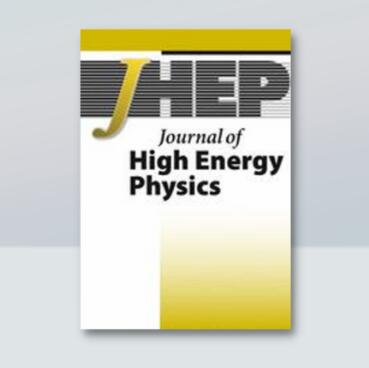全息中子星上的费米子相关器
IF 5.5
1区 物理与天体物理
Q1 Physics and Astronomy
引用次数: 0
摘要
我们研究了被称为全息中子星的渐近AdS背景的费米子微扰,它代表了有限温度下球上强耦合费米子的高度简并态。我们计算了费米子算子的两点相关器,并在接近相图的临界区域时得到了它的标度性质。本文章由计算机程序翻译,如有差异,请以英文原文为准。
Fermionic correlators on the holographic neutron star
We investigate the fermionic perturbations of the asymptotically AdS background known as holographic neutron star, which represents a highly degenerate state of strongly coupled fermions on a sphere at finite temperature. We calculate the two-point correlator of a fermionic operator and obtain its scaling properties as we approach the critical region of the phase diagram.
求助全文
通过发布文献求助,成功后即可免费获取论文全文。
去求助
来源期刊

Journal of High Energy Physics
物理-物理:粒子与场物理
CiteScore
10.30
自引率
46.30%
发文量
2107
审稿时长
1.5 months
期刊介绍:
The aim of the Journal of High Energy Physics (JHEP) is to ensure fast and efficient online publication tools to the scientific community, while keeping that community in charge of every aspect of the peer-review and publication process in order to ensure the highest quality standards in the journal.
Consequently, the Advisory and Editorial Boards, composed of distinguished, active scientists in the field, jointly establish with the Scientific Director the journal''s scientific policy and ensure the scientific quality of accepted articles.
JHEP presently encompasses the following areas of theoretical and experimental physics:
Collider Physics
Underground and Large Array Physics
Quantum Field Theory
Gauge Field Theories
Symmetries
String and Brane Theory
General Relativity and Gravitation
Supersymmetry
Mathematical Methods of Physics
Mostly Solvable Models
Astroparticles
Statistical Field Theories
Mostly Weak Interactions
Mostly Strong Interactions
Quantum Field Theory (phenomenology)
Strings and Branes
Phenomenological Aspects of Supersymmetry
Mostly Strong Interactions (phenomenology).
 求助内容:
求助内容: 应助结果提醒方式:
应助结果提醒方式:


